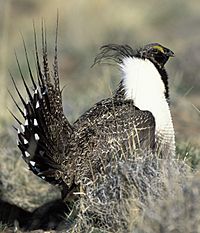Grouse facts for kids
Quick facts for kids Grouse |
|
|---|---|
 |
|
| Male Greater Sage-grouse Centrocercus urophasianus |
|
| Scientific classification | |
| Kingdom: | |
| Phylum: | |
| Class: | |
| Subclass: | |
| Infraclass: | |
| Order: | |
| Family: | |
| Subfamily: |
Tetraoninae
Vigors, 1825
|
| Genera | |
|
Bonasa |
|
| Synonyms | |
|
Tetraonidae Vigors, 1825 |
|
Grouse are a type of bird that lives on the ground. They are often hunted for sport, so they are called 'game birds'. Grouse are part of a larger group of birds called Galliformes, which also includes chickens and turkeys. Many scientists think grouse belong to their own family, called Tetraonidae. Others place them in the Phasianidae family, which includes pheasants.
Grouse look a bit like hens. Their feathers are usually brown, gray, or red. This helps them blend in with their surroundings. Even their legs are covered in feathers!
Contents
What Do Grouse Look Like?
Grouse are strong, heavily built birds. They are similar in shape to chickens. Their size can vary a lot. They can be from 31 to 95 cm (12 to 37 in) long. Their weight ranges from 0.3 to 6.5 kg (0.66 to 14.33 lb).
Male grouse are usually bigger than females. For example, a male western capercaillie can be twice as heavy as a female. The capercaillie is the largest type of grouse. Grouse even have feathers around their nostrils. Their legs and toes are covered in feathers. This helps them walk on snow and dig into it for shelter in winter. Unlike many other birds in their group, grouse do not have spurs on their legs.
What Do Grouse Eat?
Grouse mostly eat plants. Things like buds, catkins (which are soft, hanging clusters of flowers), leaves, and twigs make up most of their diet. This means their food changes a lot depending on the season.
Baby grouse, called hatchlings, eat mostly insects and other small creatures without backbones, like worms. As they grow older, they start eating more plants. Some grouse that live in forests eat a lot of conifer needles. Most other animals do not like to eat these.
To help them digest tough plant food, grouse have large crops and gizzards. A crop is a pouch in their throat for storing food. A gizzard is a muscular stomach that grinds food. They also swallow small stones, called grit, to help break down their food. Grouse have long intestines with special pouches called caeca. Inside these caeca, tiny helpful bacteria work to digest cellulose, which is a tough part of plant cell walls.
Grouse Habits and Social Life
Grouse that live in forests usually only gather in groups during autumn and winter. However, they are usually fine with other grouse being nearby. Grouse that live in open grasslands are more social. The grouse that live in cold, snowy areas, like ptarmigans, are the most social. They can form flocks of up to 100 birds in winter.
All grouse spend most of their time on the ground. If they get scared, they might suddenly fly up. Then they will glide for a long distance. Most grouse stay in the same area all year. But some, like the rock ptarmigan and willow grouse, travel hundreds of kilometers. This is a type of migration.
Grouse Life Cycle
In almost all types of grouse, the males have many mates. This is called being polygamous. Many species of grouse have special courtship displays. These are like dances or shows that males put on to attract females. They happen on the ground at dawn and dusk. Some species gather in special areas called leks for these displays.
During their displays, males show off their bright red combs (fleshy growths above their eyes). Some also have colorful air sacs on their necks that they can inflate. The males show off their beautiful plumage (feathers). They also make different sounds, which vary a lot between species. They might drum with their wings, flutter them, rattle their tails, or perform special display flights. Sometimes, males will even fight each other.
The female grouse builds her nest on the ground. It is usually a shallow dip or scrape in the dirt. She often hides it under plants. The nest has a small lining of plant material. The female lays one set of eggs, called a clutch. If these eggs are lost, she might lay another clutch. She starts laying eggs about a week after mating. She lays one egg every day or two. A clutch usually has five to 12 eggs. The eggs look like chicken eggs and are pale yellow with a few brown spots.
The female starts sitting on the eggs to keep them warm (this is called incubation) when she lays the second-to-last or last egg. Incubation lasts for 21 to 28 days. When the chicks hatch, they are covered in thick, yellow-brown downy feathers. They leave the nest right away. They grow their main feathers quickly and can fly before they are two weeks old. The female stays with them and protects them until their first autumn. By then, they have reached their adult size. The male willow grouse also helps protect the chicks. Grouse are ready to have their own babies the next spring, but they often wait a few more years to mate.
Images for kids
See also
 In Spanish: Tetraóninos para niños
In Spanish: Tetraóninos para niños


